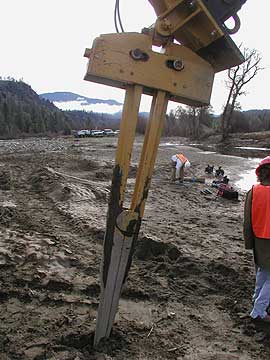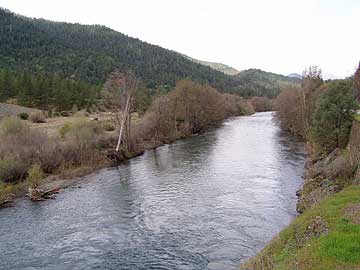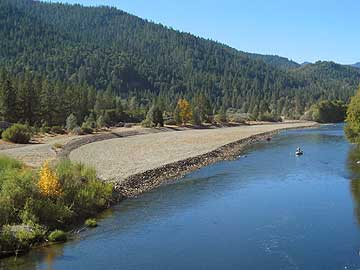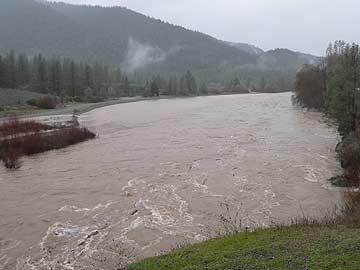Finishing Touches on Hocker Flat Channel Rehabilitation Site
By: Joe Reiss, Civil Engineer,
Trinity River Restoration Program
 |
Located in Junction City, starting where Canyon Creek enters the Trinity River and extending 1 mile downstream, Hocker Flat is the first of over 40 channel rehabilitation projects planned by the Trinity River Restoration Program for construction over the next 5 years. On the ground restoration work at Hocker Flat began in February of last year when the TCRCD cleared riparian vegetation to minimize impacts to birds that would otherwise be nesting at the start of construction activities. The construction contract was awarded to Erick Ammon, Inc. (Salyer, CA) and construction began in August. More than 93,000 cubic yards of excavation, earthwork activities were finished in mid-October. A series of winter storms hit the area starting in mid-December, and flows in the Trinity River at Hocker Flat exceeded 6,000 cubic feet per second (cfs), the flow at which the constructed floodplain surfaces were designed to begin to flood and start nature’s portion of the restoration work. Flows at Hocker Flat peaked at about 24,000 cfs at midnight on New Year’s Eve, resulting in the creation of high flow channels, sediment deposition and scour, and large woody debris landing on floodplain surfaces: exactly what the TRRP hoped would happen.
Following construction activities and the winter storms, Hocker Flat was ready for revegetation. The District has worked closely with the TRRP on revegetation concepts under the supervision of Bernadette Cooney, the District’s Revegetation Coordinator, and has been growing plants from seeds and cuttings in preparation for planting at Hocker Flat. The goal of revegetating the rehabilitation sites is to introduce a diverse mixture of native riparian (streamside) plants to the outer edges of the constructed floodplains to provide food and shelter for juvenile salmonids and wildlife. In contrast, much of the today’s Trinity River is confined by riparian berms formed by encroachment of white alder, Himalayan blackberry (non-native and invasive), and narrowleaf willow. Riparian species planted at Hocker Flat include black cottonwood, arroyo willow, red willow, shiny willow, Oregon ash, and white alder. Upland areas, where the excavated materials were deposited, were planted with a variety of native, drought tolerant trees, shrubs, grasses and wildflowers, with the goal of minimizing aesthetic impacts and to discourage colonization by noxious and invasive species.
One of the most challenging aspects of revegetating Hocker Flat was actually putting the riparian plants into the ground, which is comprised of sand and silt with cobbles up to 2-feet in diameter. The planting plan called for placing over 3,000 cottonwood and willow “pole” cuttings at least 4 feet deep into the groundwater table. To do so with conventional methods (e.g. backhoe or by hand) would have taken several weeks and been cost prohibitive. That’s where the “Stinger” came in. The Stinger is an excavator attachment used specifically for planting in difficult areas, and was developed for planting willows in rip-rapped banks. The District contracted Erick Ammon, Inc. for the excavator work, and Northwest Revegetation and Ecological Restoration (Hamilton, Montana) for the Stinger and technical support. In just 4 days, the District and the Stinger planted over 3 acres of riparian vegetation, putting in over 500 plants per day.
 |
The earthwork and revegetation activities at Hocker Flat are complete, but these are just the initial steps towards restoring the Trinity River’s fishery. The TRRP will monitor the site after construction, but it will be up to Mother Nature to bring the flows, sediment, seeds and salmon to continue the restoration process.
 |
Hocker Flat, Pre Construction
at 450 cfs Flow.
|
 |
Hocker Flat, Post Construction
at 450 cfs Flow.
|
 |
Hocker Flat, Post Construction
Winter Flood at 14,000 cfs.
|
 |
Hocker Flat, Post Winter Flood
at 7,400 cfs.
|
|









